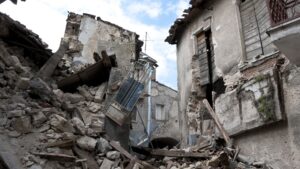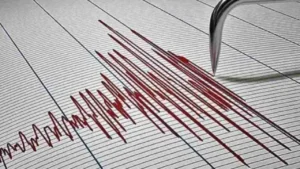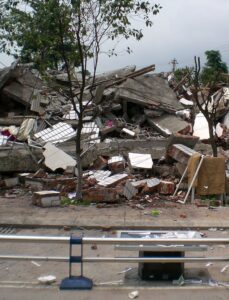Earthquakes triggered by the shifting of tectonic plates, continue to cause widespread destruction and trauma across the globe. Although earthquakes themselves are not directly caused by climate change, emerging research shows that changing climate conditions may indirectly affect fault lines and earthquake risks. With worsening climate impacts, earthquake-prone areas could face greater vulnerabilities, adding pressure to infrastructure, insurance systems, and disaster response mechanisms worldwide.
 How Are Earthquakes Formed?
How Are Earthquakes Formed?
Tectonic plates are always moving, though we usually don’t notice it.
Earthquakes form when Plates move apart (divergent boundaries), Plates collide into each other (convergent boundaries), or Plates slide past each other (transform boundaries).
At these boundaries stress builds up over years or centuries. When it becomes too great for the rocks to withstand, they fracture, causing the sudden shaking we recognize as an earthquake.
How Are Earthquakes Measured?

Scientists use seismographs to measure earthquakes. These devices record the motion of the ground during an earthquake.
There are two main ways earthquakes are measured:
Magnitude (size of the energy released):
Measured on the Richter Scale or newer Moment Magnitude Scale (Mw).
Each whole number increase means about 32 times more energy released.
Consequences and Emotional Impact of Earthquakes
The aftermath of an earthquake can be devastating collapsed buildings, costly damages, injuries, and loss of life. Survivors may also endure long-term psychological trauma, such as eco-anxiety or PTSD, especially when loved ones or homes are lost.
In addition to physical damage, earthquakes strain financial systems, requiring expensive rebuilding efforts and often overwhelming local resources. Some areas may take years, if not decades, to fully recover.
Living in Earthquake-Prone Zones: Preparation

Communities in earthquake zones adopt specific safety norms, such as regular earthquake drills in schools and recommendations for homeowners to invest in special earthquake insurance policies. Understanding and accepting the risks and preparing accordingly becomes a way of life.
Insurance companies, however, are feeling the strain as climate-related risks grow. With climate change making disasters more frequent and severe, industries like insurance are struggling to keep up with the financial costs, and this may worsen with future earthquakes.
What Scientists Understand (and Still Don’t) About Earthquakes
Scientists today know much more about earthquakes than they did fifty years ago. However, accurately predicting earthquakes before they occur remains elusive. Despite advancements in seismic monitoring and fault line research, there is no reliable method yet to forecast earthquakes with precision.
This scientific uncertainty keeps earthquake-prone regions constantly vigilant, relying heavily on early warning systems and strong infrastructure resilience rather than prediction.
Does Climate Change Affect Earthquakes?
Not directly, but indirectly, yes.
Earthquakes fundamentally arise from tectonic movements, which are unrelated to climate change. However, human activities influenced by climate conditions such as excessive groundwater pumping during droughts can exacerbate stress on fault lines. Severe droughts may further weaken crustal integrity, and changes in atmospheric pressure from powerful hurricanes (worsened by climate change) may also influence earthquake-prone zones.
0Over long periods, geological shifts triggered by earthquakes can slightly alter regional climates, although this is more of a geological timescale process rather than an immediate climate concern.
Earthquakes and Climate Change: A Dangerous Combination?
Even if earthquakes aren’t becoming stronger directly because of climate change, their impacts are becoming harder to manage because of it.
For example, as climate change intensifies droughts, storms, and economic instability, it becomes more difficult for individuals and governments to recover from additional shocks like earthquakes. Damaged infrastructure, overwhelmed insurance companies, and fragile economies mean communities are less equipped to rebuild after disaster strikes.
In the U.S., major insurance providers are already pulling back coverage in disaster-prone areas due to climate risks. Combined with the devastating potential of an earthquake, especially in underprepared or vulnerable regions, the economic and social costs could be catastrophic.
Precautions for People in Earthquake-Prone Areas
People who live in areas where earthquakes happen often prepare in special ways:
- Drop, Cover, and Hold On:
When shaking starts, drop to the ground, take cover under sturdy furniture, and hold on.
- Participate in Drills:
Schools and offices often practice earthquake drills to train people on how to react quickly.
- Secure Heavy Objects:
Fasten shelves, mirrors, and appliances securely to walls to prevent falling.
- Create Emergency Kits:
Keep essential supplies water, food, flashlights, batteries, first aid kit, important documents ready.
- Plan Evacuation Routes:
Know safe exits and open spaces nearby to move quickly after an earthquake.
- Retrofit Buildings:
Strengthen old structures to make them more resistant to shaking.
- Get Earthquake Insurance:
In highly vulnerable areas, special insurance can protect financially after a disaster.
Being prepared can make the difference between survival and tragedy during a major earthquake.
Analysis: Why Understanding This Link Matters for Future Disaster Planning
- Preparedness strategies must evolve: Earthquake readiness cannot happen in isolation. Disaster response planning must account for compounded risks from climate change, including weakened infrastructure, instability, and vulnerable populations.
- Infrastructure must be climate- and quake-resilient: Building codes, especially in earthquake-prone zones, must integrate resilience to both seismic shocks and climate-driven stresses like flooding, fires, and heatwaves.
- Insurance models need reform: With both earthquake and climate disaster risks rising, governments and insurers must rethink how to provide affordable, sustainable coverage without leaving vulnerable communities exposed.
- Public awareness must increase: People living near fault lines need better access to education about both earthquake risks and how climate change may worsen post-disaster recovery challenges.
- Global cooperation is key: Since neither earthquakes nor climate disasters respect borders, international coordination on early warning systems, humanitarian aid, and disaster response frameworks is more important than ever.
Written by Vaishali Verma
Sub-editor, DisastersNews
